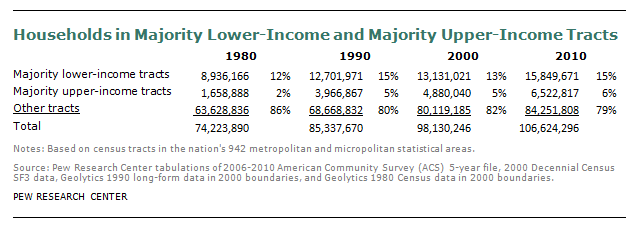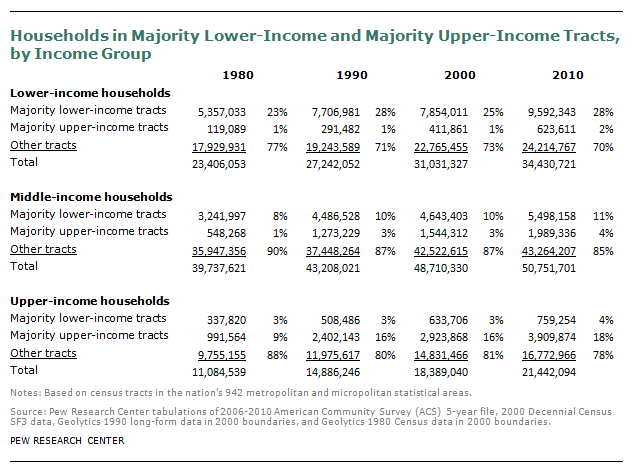In this section of the report, we turn the frame of analysis from the household (which was the unit of analysis in chapters 1 and 2) to the census tract. We also compare trends in residential segregation by income with trends in residential segregation by race.

In 2010, most households (79%) lived in a tract in which at least half of the households were middle income or in which no income group comprised a majority of households. An additional 15% of the nation’s households resided in a majority lower-income tract, and 6% of the nation’s households resided in a majority upper-income tract. The share of the nation’s households residing in majority lower-income tracts and majority upper-income tracts has risen since 1980. In 1980, 12% of households were in majority lower-income tracts and 2% were in majority upper-income tracts.
Though it remains the case that most (72%) lower-income households do not live in a majority lower-income tract, the tendency of the nation’s lower-income households to live in majority lower-income census tracts has risen since 1980. In 2010, 28% of lower-income households lived in majority lower-income tracts, an increase from 23% in 1980.
Most upper-income households did not live in a majority upper-income census tract, but more do now than did in 1980. In 2010, 18% of the nation’s upper-income households resided in a majority upper-income tract. Thirty years earlier, 9% of upper-income households resided in majority upper-income tracts.
The number of majority lower-income census tracts has grown over time, from 12% of all tracts in 1980 to 18% in 2010. But, on average, these majority lower-income tracts have not grown more highly concentrated with lower-income households. In 1980, the average majority lower-income tract was composed of 60% lower-income households. In 2010, the majority of lower-income tracts were 61% lower income. Thus it appears that more lower-income households live in majority lower-income tracts simply because there are more such tracts, not because a growing number of lower-income households are more densely packed into a stable number of such tracts.

Looking at the trends from 1980 to 2010, it is also clear that residing in a majority upper-income tract has not reduced the exposure of its residents to neighbors who are lower income. In 1980, the average majority upper-income tract was made up of 7% lower-income households. By 2010, the typical majority upper-income tract had 10% lower-income households.
Comparisons with Racial and Ethnic Isolation
Residential isolation by race is more prevalent than residential isolation by income. In 2010, 42% of blacks lived in a census tract that was majority black, compared with 28% of low-income households living in a majority low-income tract and 18% of upper-income households living in a majority upper-income tract.6
Another way to look at racial segregation is to analyze the racial makeup of the census tract where the typical person of a given race lives. In 2010, the typical African American resided in a census tract whose population was 45% African American, though African Americans comprised only 12% of the population. The typical white person (63% of the population) lived in a tract that was 77% white; the typical Hispanic (17% of the population) resided in a tract that was 45% Hispanic; and the typical Asian or Pacific Islander (5% of the population) resided in a tract that was 21% Asian or Pacific Islander.
Applying this same metric to residential segregation by income, one finds that in 2010 the typical lower-income household (32% of the population) was located in a tract that was 41% lower income and the typical upper-income household (20% of the population) was located in a tract that was 32% upper income. In other words, although these two minority income groups are larger than Hispanics (17%) and African Americans (12%), the two income groups are less likely to be clustered among themselves.
As for trends over time in racial segregation, one of the major findings arising from the 2010 Census is that black-white segregation continues to decline in America (Glaeser and Vigdor, 2012; Logan and Stults, 2011; Frey, 2011). In 1980, the typical black American lived in a census tract that was 58% black; by 2010, that share dropped to 45%.
However, residential segregation of Hispanic and Asian Americans may not have decreased—in part because the populations of these two minority groups have grown during this period, thereby creating larger pools for potential ethnic and racial clustering. In 1980, the typical Hispanic resided in a tract that was 38% Hispanic (compared with 45% in 2010) and the typical Asian or Pacific Islander resided in a tract that was 19% Asian or Pacific Islander (compared with 21% in 2010).7




